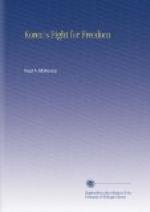They found Seoul, the capital, beautifully placed in a valley surrounded by hills, a city of royal palaces and one-storied, mud-walled houses, roofed with thatch—a city guarded by great walls. Statesmen and nobles and generals, always surrounded by numerous retinues in glorious attire, ambled through the narrow streets in dignified procession. Closed palanquins, carried by sturdy bearers, bore yet other dignitaries.
The life of the city revolved round the King’s Court, with its four thousand retainers, eunuchs, sorcerers, blind diviners, politicians and place hunters. The most prominent industry—outside of politics—was the making of brass ware, particularly of making fine brass mounted chests. The average citizen dressed in long flowing white robes, with a high, broad-brimmed, black gauze hat. Hundreds of women were ever busy at the river bank washing these white garments.
Women of good family remained at home, except for one hour after dark, when the men retired from the streets and the women came out. Working women went to and fro, with their faces shielded by green jackets thrown over their heads. Their usual dress was a white skirt coming high up and a very short jacket. The breasts and the flesh immediately below the breasts were often freely displayed. Fishing and farming supported ninety per cent of the population, and the Korean farmer was an expert. At sunset the gates of Seoul were closed, and belated wayfarers refused admission until morning. But there was no difficulty in climbing over the city walls. That was typical. Signal fires at night on the hills proclaimed that all was well.
The Koreans were mild, good natured, and full of contradictory characteristics. Despite their usual good nature, they were capable of great bursts of passion, particularly over public affairs. They often looked dirty, because their white clothes soiled easily; yet they probably spent more time and money over external cleanliness than any other Asiatic people. At first, they gave an impression of laziness. The visitor would note them sleeping in the streets of the cities at noon. But Europeans soon found that Korean labourers, properly handled, were capable of great effort. And young men of the cultured classes amazed their foreign teachers by the quickness with which they absorbed Western learning.
The land was torn, at the time of the entry of the foreigners, by the rivalry of two great families—the Yi’s, the blood relatives of the King, and the Mins, the family of the Queen. The ex-Regent was leader of the Yi’s. He had exercised absolute power for many years during the King’s minority, and attempted to retain power even after he ceased to be Regent. But he reckoned without the Queen. She was as ambitious as the Regent. The birth of a son greatly improved and strengthened her authority, and she gradually edged the Regent’s party out of high office. Her brother, Min Yeung-ho, became




